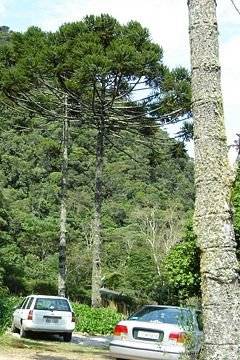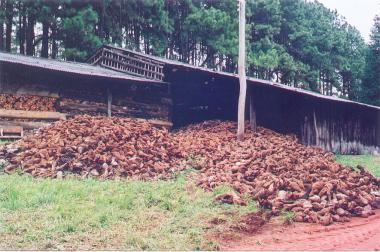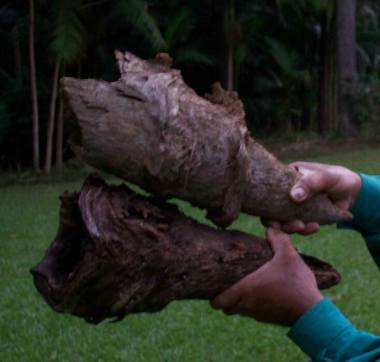The "Nó
de Pinho" ( Brazilian for "Araucaria-Pinetree-Knots" )
is used so far, almost exclusively in Brazil, as the best natural firewood
available. It is nowadays sold in 10 Kg or 15 kg bags.
.
These "knots", heavy
pieces of 'conic-shaped' wood, which during many centuries resisted
to decay under the soil, long after the trunks they were originated from
had been naturally decomposed. These 'resin-impregnated'-KNOTS (the
intersection of the big branches to their trunks) remained unchanged in
the soil and actually can only be desintegrated by fire. Their average
size is 30 cm long by 15 cm diameter.
.
While burning in a
fireplace the flame lasts for several hours. A wise user, mixes
them up with mature Eucalyptus firewood in order to provide intense heating,
and saving the precious knots. |
 |
.We
may antecipate that in a decade or so the "Nó de Pinho" will not
be available anymore. The ones presently used are remnants of the trees
which existed many hundreds of years ago.
Origin: For
hundreds of years, those huge Araucaria-trunks kept falling to the ground
due to "aging" (the end of their life cycle), being struck
by lightning, fires etc.
Nowadays, while
plowing their land, farmers collect the knots found, pile them up for providing
an "additional income", to sell them as fire-wood.
Every year they become
more scarce. The Brazilian South East was for thousands of years
covered by the so called "Atlantic Forest" ( Brazilian designation
for Native forests along the Atlantic ). Particularly in the brazilian
Southern States: Paraná, Santa Catarina and Rio Grande do Sul, Sao
Paulo and Minas Gerais, the dominant species was the ARAUCARIA, also
designated "Pinheiro do Paraná" - araucaria angustifolia
and araucaria brasiliensis.
.
These trees reach
up to 52 meters height and their trunk up to 8,5 meters circumference.
Their cones are shaped like a ball with over 30 cm diameter and provide
seeds averaging 6 cm length. (These are edible by animals,
also for humans, who boil them adding some butter and salt ). |
 |
.
The lumber industry
(thousands of saw-mills) exploited these Araucaria forests almost to exhaustion,
mainly for export. That "boom" which provided many thousands of jobs
lasted only until mid last century.( 1950's)
Brazilian authorities
nowadays protect the natural forests and particularly the remnants
of Araucaria forests. These days, the cutting of any Araucaria, as well
as any native tree, requires a special permit from the local environment
department. |



